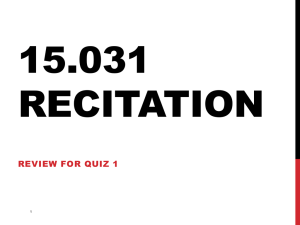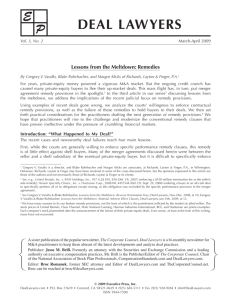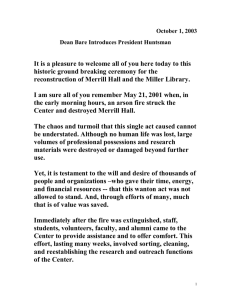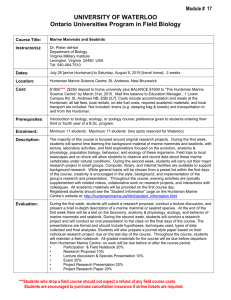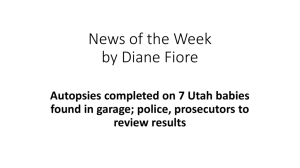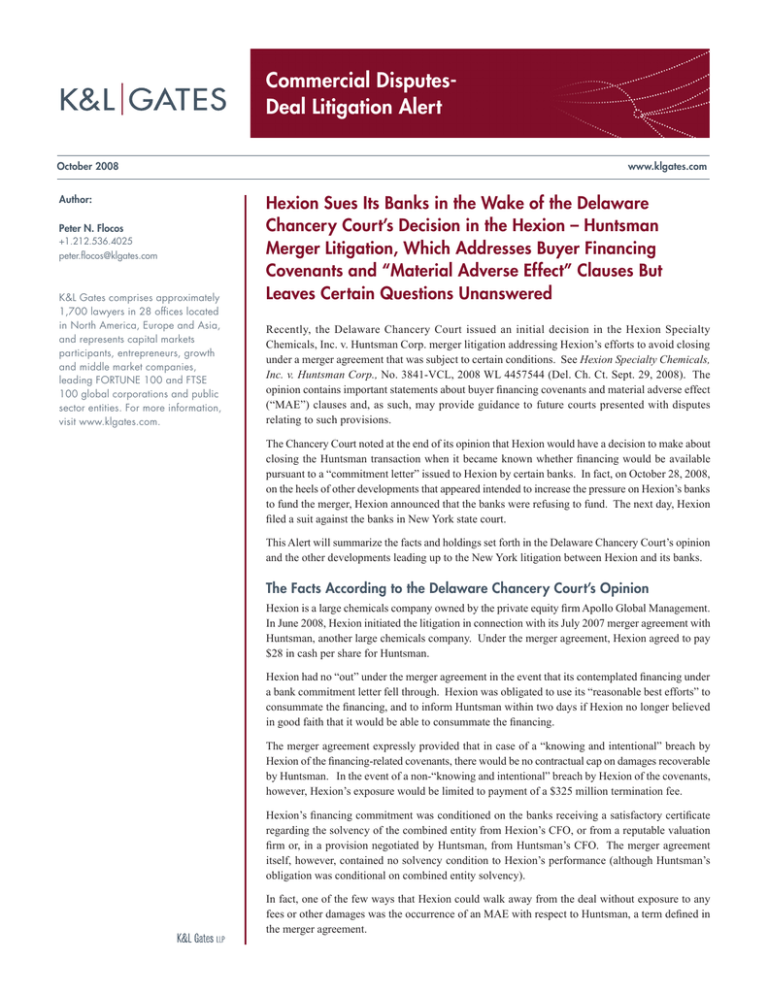
Commercial DisputesDeal Litigation Alert
October 2008
Author:
Peter N. Flocos
+1.212.536.4025
peter.flocos@klgates.com
K&L Gates comprises approximately
1,700 lawyers in 28 offices located
in North America, Europe and Asia,
and represents capital markets
participants, entrepreneurs, growth
and middle market companies,
leading FORTUNE 100 and FTSE
100 global corporations and public
sector entities. For more information,
visit www.klgates.com.
www.klgates.com
Hexion Sues Its Banks in the Wake of the Delaware
Chancery Court’s Decision in the Hexion – Huntsman
Merger Litigation, Which Addresses Buyer Financing
Covenants and “Material Adverse Effect” Clauses But
Leaves Certain Questions Unanswered
Recently, the Delaware Chancery Court issued an initial decision in the Hexion Specialty
Chemicals, Inc. v. Huntsman Corp. merger litigation addressing Hexion’s efforts to avoid closing
under a merger agreement that was subject to certain conditions. See Hexion Specialty Chemicals,
Inc. v. Huntsman Corp., No. 3841-VCL, 2008 WL 4457544 (Del. Ch. Ct. Sept. 29, 2008). The
opinion contains important statements about buyer financing covenants and material adverse effect
(“MAE”) clauses and, as such, may provide guidance to future courts presented with disputes
relating to such provisions.
The Chancery Court noted at the end of its opinion that Hexion would have a decision to make about
closing the Huntsman transaction when it became known whether financing would be available
pursuant to a “commitment letter” issued to Hexion by certain banks. In fact, on October 28, 2008,
on the heels of other developments that appeared intended to increase the pressure on Hexion’s banks
to fund the merger, Hexion announced that the banks were refusing to fund. The next day, Hexion
filed a suit against the banks in New York state court.
This Alert will summarize the facts and holdings set forth in the Delaware Chancery Court’s opinion
and the other developments leading up to the New York litigation between Hexion and its banks.
The Facts According to the Delaware Chancery Court’s Opinion
Hexion is a large chemicals company owned by the private equity firm Apollo Global Management.
In June 2008, Hexion initiated the litigation in connection with its July 2007 merger agreement with
Huntsman, another large chemicals company. Under the merger agreement, Hexion agreed to pay
$28 in cash per share for Huntsman.
Hexion had no “out” under the merger agreement in the event that its contemplated financing under
a bank commitment letter fell through. Hexion was obligated to use its “reasonable best efforts” to
consummate the financing, and to inform Huntsman within two days if Hexion no longer believed
in good faith that it would be able to consummate the financing.
The merger agreement expressly provided that in case of a “knowing and intentional” breach by
Hexion of the financing-related covenants, there would be no contractual cap on damages recoverable
by Huntsman. In the event of a non-“knowing and intentional” breach by Hexion of the covenants,
however, Hexion’s exposure would be limited to payment of a $325 million termination fee.
Hexion’s financing commitment was conditioned on the banks receiving a satisfactory certificate
regarding the solvency of the combined entity from Hexion’s CFO, or from a reputable valuation
firm or, in a provision negotiated by Huntsman, from Huntsman’s CFO. The merger agreement
itself, however, contained no solvency condition to Hexion’s performance (although Huntsman’s
obligation was conditional on combined entity solvency).
In fact, one of the few ways that Hexion could walk away from the deal without exposure to any
fees or other damages was the occurrence of an MAE with respect to Huntsman, a term defined in
the merger agreement.
Commercial Disputes-Deal Litigation Alert
On April 22, 2008, months after execution of the July 2007
merger agreement but prior to closing, Huntsman reported
poor first quarter 2008 results. According to the Court,
Hexion-Apollo and their counsel met at that time to discuss
the possibility that an MAE had occurred but, “perhaps
realizing that the MAE argument was not strong,” they
began to focus on the potential insolvency of the combined
company. See id. at *5. In that connection, Hexion-Apollo
and their counsel obtained an opinion from Duff & Phelps
that the combined entity would be insolvent.
Upon receiving the Duff & Phelps opinion on June 18, 2008,
Hexion filed suit against Huntsman and published the opinion
as part of the suit. Hexion’s suit sought a declaration that
(1) Huntsman had suffered an MAE and Hexion therefore
had no obligation to close, and (2) Hexion could be liable
to Huntsman for no more than the $325 million termination
fee, because financing could not be obtained as a result of
the insolvency that Hexion alleged would exist if the merger
closed, and therefore there was no “knowing and intentional”
breach by Hexion.
The Court’s Holdings
The Court found that no MAE had occurred and that Hexion
was in breach of the merger agreement. In summary, the
Court held as follows:
• A Buyer Who Wants to Walk Away Based on an
Alleged MAE Has the Burden of Proof. Absent
“clear language to the contrary,” the buyer, as the
party seeking to excuse performance, has the burden
of proving that an MAE has occurred, particularly
where the buyer has initiated litigation seeking an MAE
declaration. See id. at *16.
• E
BITDA Should Be the Measure of Whether an
MAE Has Occurred. Earnings before interest, taxes,
depreciation and amortization (“EBITDA”), unlike
earnings per share, is independent of capital structure
and therefore was “a better measure of the operational
results of the business” in this transaction for MAE
purposes. Increases in debt would not be relevant, at
least where not significantly different than the debt
level assumed in Hexion’s valuation model. See id.
• F
ailure to Meet Projections Provided to Bidders
Does Not Drive the MAE Analysis If Projections
Are Disclaimed. The merger agreement contained
a typical disclaimer of any representations regarding
projections furnished by Huntsman. In light of such a
provision, Huntsman’s failure to meet those projections
during the period leading up to closing “cannot be a
predicate to the determination of an MAE.” Apollo
moreover had acknowledged on cross-examination
that it never fully believed Huntsman’s forecasts. The
“proper benchmark” is to “examine each year and
quarter and compare it to the prior year’s equivalent
period.” See id. at *17-18.
he Court therefore did not appear to give weight to
T
the fact that Huntsman’s second-half 2007 EBITDA
was 22% below the projections Huntsman presented to
bidders in June 2007 for the rest of the year, and that
Huntsman’s presently estimated 2008 EBITDA was
32% below the forecasts of 2008 EBITDA Huntsman
had provided as part of the sale process.
• A
n MAE Requires a “Durationally Significant”
Change to Earnings. Noting that no Delaware court
has ever found an MAE in the context of a merger
agreement, the Court held that a “short-term hiccup
in earnings should not suffice for an MAE.” Rather,
the MAE should be “material when viewed from the
longer-term perspective of a reasonable acquirer.”
Poor earnings results “must be expected to persist
significantly into the future” before an MAE may be
found. See id. at *15.
• H
untsman’s EBITDA Declines Were Not an MAE.
Applying the framework summarized above, the Court
held there was no MAE. The Court stated: “Huntsman’s
2007 EBITDA was only 3% below its 2006 EBITDA,
and, according to Huntsman management forecasts,
2008 EBITDA will only be 7% below 2007 EBITDA.
Even using Hexion’s much lower estimate of
Huntsman’s 2008 EBITDA, Huntsman’s 2008 EBITDA
would still be only 11% below its 2007 EBITDA. And
although Huntsman’s fourth quarter 2007 EBITDA
was 19% below its third quarter 2007 results, which
were in turn 3% below its second quarter 2007 results,
Huntsman has historically been down on a quarter-overquarter basis in each of the third and fourth quarters of
the year. . . . Moreover, comparing the trailing-twelvemonths EBITDA for second quarter 2007 to second
quarter 2008, the 2008 result is only down 6% from
2007.” See id. at *18.
he Court also noted that if one used for 2009 EBITDA
T
a figure somewhere in between Huntsman and Hexion
forecasts, which would be consistent with analyst
estimates, that figure “would represent a mere 3.6%
decrease in EBITDA from 2006 to 2009, and a result
essentially flat from 2007 to 2009.” See id. at *19.
t least in this context, the Court seemed unimpressed
A
that Huntsman’s first-half 2008 EBITDA was down
19.9% year-over-year from its first-half 2007 EBITDA.
October 2008 | 2
Commercial Disputes-Deal Litigation Alert
• “ Knowing and Intentional” Breach. Rejecting
Hexion’s more stringent interpretation, the Court defined
a “knowing and intentional” breach as “the taking of a
deliberate act, which act constitutes in and of itself a
breach of the merger agreement, even if breaching was
not the conscious object of the act.” See id. at *21. The
Court held that Hexion knowingly and intentionally
breached its financing-related covenants, and even
acted in bad faith, by not using reasonable best efforts
to consummate the bank financing and by not keeping
Huntsman informed of its solvency views.
he Court specifically found that after Huntsman’s
T
first quarter 2008 results were announced, “Apollo and
its counsel began to follow a carefully designed plan
to obtain an insolvency opinion, publish that opinion
(which it knew, or reasonably should have known,
would frustrate the financing), and claim Hexion did
not ‘knowingly and intentionally’ breach its contractual
obligations to close (due to the impossibility of obtaining
financing without a solvency certificate),” so as to limit
Hexion’s damages to the $325 million termination fee.
See id. at *5.
oreover, the Duff & Phelps opinion was “unreliable,”
M
based on “skewed” numbers provided by Apollo, and
“produced without any consultation with Huntsman.”
See id. at *7.
lthough the “best efforts” financing covenant did
A
not require Hexion to merge itself into bankruptcy, it
did require Hexion to examine all viable options that
would allow it to perform “without disastrous financial
consequences.” Hexion appeared to have “made no
effort at all” to find other options and there was an
“utter failure” to attempt to confer with Huntsman
when Hexion purportedly first became concerned about
insolvency. See id. at *26-27.
Hexion Must Specifically Perform Its Merger
Agreement Financing Covenants
After examining the language of the merger agreement
regarding remedies, and other facts and circumstances, the
Court concluded that it would order Hexion to specifically
perform its financing covenants. But the Court stopped
short of ordering specific performance of the merger itself
– at least at this point. Rather, the Court noted that Hexion
would have a decision to make about closing when it became
known whether financing would be available pursuant to a
“commitment letter” issued to Hexion by certain banks. See
id. at *4, 32.
Hexion Sues Its Banks –
But What Happens Next?
According to Huntsman’s proxy materials, the merger
agreement may require Hexion, in certain circumstances, to
bring suit against its banks in the event of a failure to lend.
Last week, the Delaware Chancery Court rejected Hexion’s
request to declare that the expiration date of Hexion’s bank
financing commitment was extended to the end of November
2008, and a Texas appeals court upheld an order enjoining
Hexion’s banks from filing any lawsuit seeking to declare that
the combined Hexion/Huntsman entity would be insolvent.
That injunction was to last through November 1, 2008, unless
the merger closed before that date.
On October 28, 2008, Hexion announced that its banks were
refusing to fund the merger, based upon what the banks
stated were solvency issues. That announcement followed
an announcement the day before that Apollo and certain
Huntsman stockholders had agreed to infuse over $400
million into Hexion or the combined company – on top
of an earlier agreement by Apollo to make a $540 million
contribution to Hexion – in an apparent attempt to increase
the pressure on Hexion’s banks to fund.
On October 29, 2008, Hexion sued its banks in New York
state court seeking specific performance of what Hexion
claims is the banks’ obligation to fund the merger. If
awarded, such a remedy, which Hexion is seeking on an
expedited basis, would require the banks to provide funds to
Hexion in connection with the merger.
Deal professionals are paying close attention to the foregoing
litigation as the results, including any additional court
opinions, may provide guidance as to how courts may address
similar issues in the future.
K&L Gates comprises multiple affiliated partnerships: a limited liability
partnership with the full name K&L Gates LLP qualified in Delaware
and maintaining offices throughout the U.S., in Berlin, in Beijing (K&L
Gates LLP Beijing Representative Office), and in Shanghai (K&L Gates
LLP Shanghai Representative Office); a limited liability partnership
(also named K&L Gates LLP) incorporated in England and maintaining
our London and Paris offices; a Taiwan general partnership (K&L
Gates) which practices from our Taipei office; and a Hong Kong
general partnership (K&L Gates, Solicitors) which practices from our
Hong Kong office. K&L Gates maintains appropriate registrations in
the jurisdictions in which its offices are located. A list of the partners in
each entity is available for inspection at any K&L Gates office.
This publication/newsletter is for informational purposes and does not
contain or convey legal advice. The information herein should not be
used or relied upon in regard to any particular facts or circumstances
without first consulting a lawyer.
©2008 K&L Gates LLP. All Rights Reserved.
October 2008 | 3

